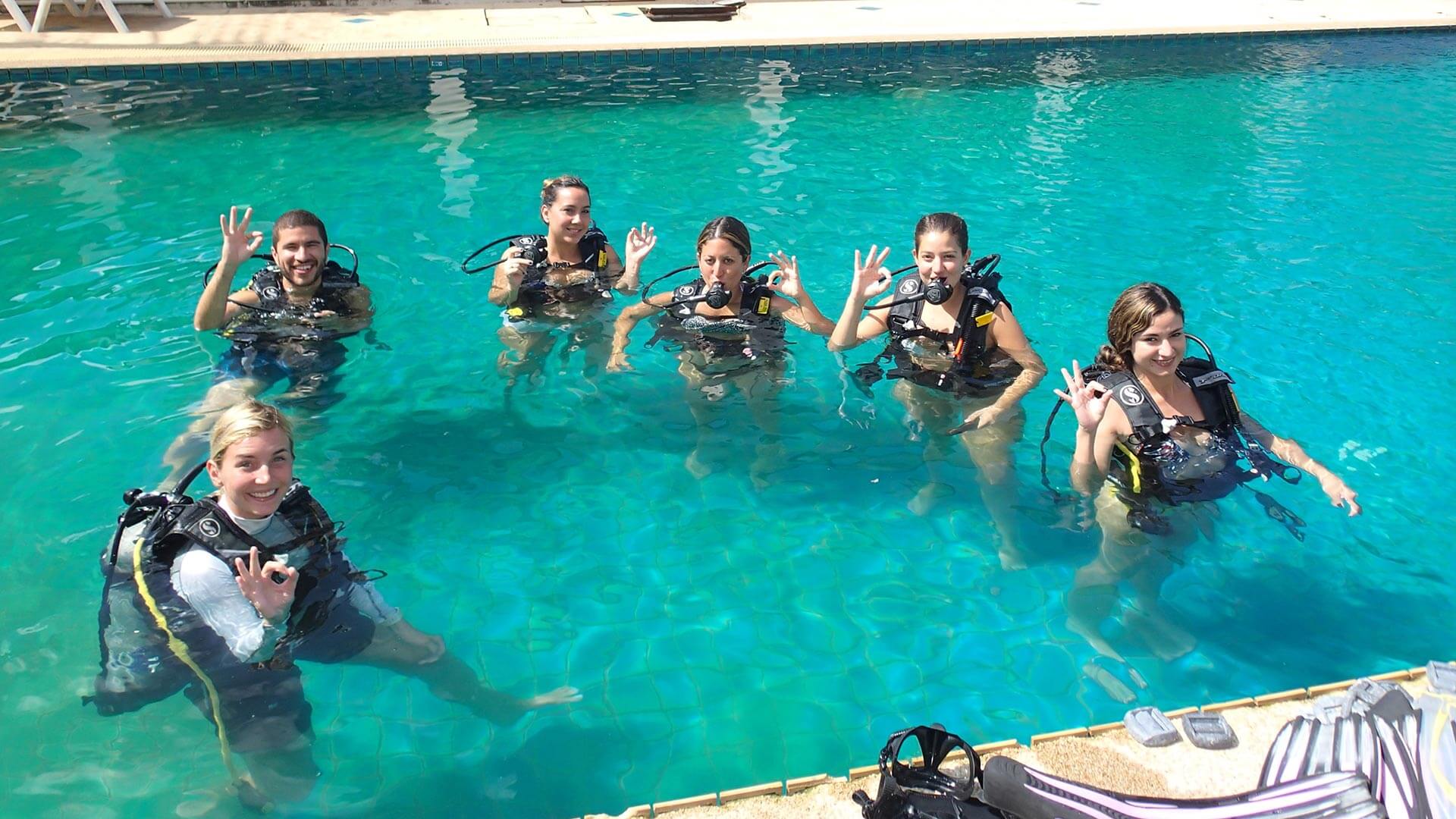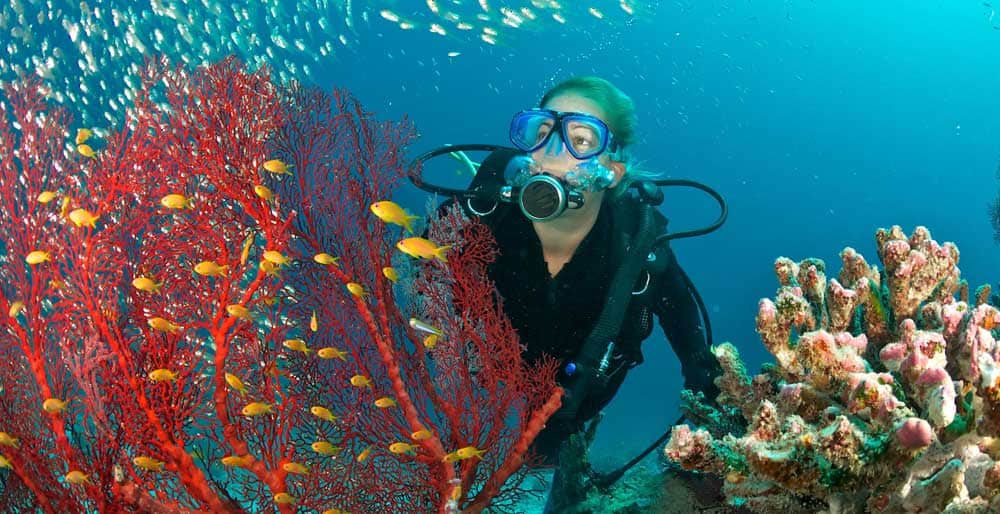*This post may contain affiliate links. As an Amazon Associate we earn from qualifying purchases.
When you’re learning how to dive, you’ll make mistakes – and that’s okay. Most diving setups are extremely user-friendly, and chances are you’ll be fine as long as you follow instructions. That said, there are a few things to remember that will help you learn how to dive like a pro.
Do I Really Need To Learn These Things?
Yes. Scuba diving has a high barrier of entry, ranging from about two dozen hand signals to movement techniques, specialized equipment, and more. You can’t just put on a suit and hop into the water. Fortunately, once you clear the barrier, you’ll be ready to dive almost anywhere in the world.
Tip #1: Slow Down

Many new divers push themselves to keep up with the more experienced members of the group. This is exactly the wrong way to go about it. Take your time to assemble and put on your gear, and don’t be afraid to ask other people to check and make sure it’s right. Most experienced divers are happy to go over safety checks – the last thing they want is an early end to the dive!
Once your gear is ready, descend only at a pace you’re comfortable with and be sure to equalize your pressure every few feet. Taking it slow will help your body adjust and ensure that you can enjoy the full experience of your trip.
Remember, most trips are planned to be slow, especially when they take place as part of scuba diving classes. Your tanks contain enough oxygen to let you have a nice, relaxing trip and still have plenty to spare when you get up to the surface. If you start feeling stressed, you may start to hyperventilate and go through your oxygen faster.
Tip #2: Invest In Personal Gear
There’s no substitute for personal gear. You know it fits, you know where every part is, and you know how to maintain it and ensure it’ll remain good for years. There are a few things to consider when investing in personal scuba diving gear.
First, while it needs to fit within your budget, you should get the best gear you can. You don’t want to put your life in the hands of a tool made by the lowest bidder, especially if you’re going well under the surface. Instead, look for parts that are going to last a long time.
Next, take some courses on maintaining your gear. If you don’t go scuba diving very often, you may forget some of the small but vital tasks that will keep you safe. Try to make a checklist of everything you need to do with your equipment. There’s a great guide for maintaining gear right here.
Finally, do what you can to try each piece of gear before you buy it. There’s no substitute for hands-on experience with gear. Online reviews can help you avoid bad products, but when you’re making a final decision, you should know exactly how it performs. The only way to do that is to go diving with it. If you can’t dive, at least try it on. Many scuba stores are happy to let you test things.

Tip #3: If You Have Questions, Ask
Every pro knows that it’s better to speak up when you have a question. For one thing, they were beginners once and know what it’s like to feel overwhelmed by everything you’re expected to know on your first dive.
For that matter, you may not be the only one with a question. When you speak up, you may be able to help them figure things out as well. It can be a little embarrassing to speak up when you’re still learning how to dive, but it’s better to be uninformed for a moment than for the whole trip.
Tip #4: Don’t Try To Do Too Many Things At Once
Scuba diving is straightforward once you know what you’re doing, but there are a lot of things to keep track of. From monitoring your air and your buoyancy to keeping an eye on the position of other divers and the location of the boat you used, you’ve got a lot of things to pay attention to.
Unfortunately, many new divers are so interested in getting too exciting things like filming that they forget to learn everything else they need to know. This is why it’s so important that you don’t try to do too many things at once.
Instead, stick with each subject until you’ve mastered it. Then – and only then – should you proceed to the next part of diving. When good diving behaviors are a habit, it’s much easier to continue practicing safe behaviors when you start adding other things.

Tip #5: Dive Regularly
Diving is a skill, and like any skill, you’re going to lose it if you don’t use it on a regular basis. In particular, you should go diving again as soon as possible once you’ve learned to scuba dive and are ready to go diving on your own. Get into the water and continue going there on a regular basis.
Personally, we recommend continuing to dive every week or two until you’ve completely mastered the skills. At that point, you can slow down and start to dive every month or three instead. You don’t want to take a class and have your next dive be ten months later, though, because you’ll have forgotten far too much of what you need to know.
Diving is safe when done properly, but if you start doing things wrong, you could end up hurting yourself.
Tip #6: Practice Your Hand Signals
Hand signals are your best way of communicating with others when diving – and there are quite a few of them. With the right signals, you can do everything from asking for a rest to directing an entire group towards an interesting sight.
Unlike sports above the waves, though, you can’t just ask anything on your mind – and there’s a limited amount of clarification that should be given. You should learn every signal, starting with the common signals, and practice them on a regular basis.
Be sure to practice combinations of these as well – especially with your diving buddy. If one of you misunderstands something, it could lead to a dangerous situation. Try to avoid making up signals of your own – other divers won’t know those, and you may forget that they won’t understand if you’ve been using them for years.
(The exception to this, of course, is if you teach them a specific signal beforehand. This is usually used to identify local fish and the like.)

Tip #7: Practice The Five-Point Descent
Pros use a five-point descent system to get to their destination safely – and you should, too. This simple system makes it each to enjoy your trip to the fullest while remaining safe. Here’s the system.
- Signal: The first step is signaling to your diving buddy that you intend to go down. You may need to add an extra signal to tell them how far you plan to go, though it’s always better if you have a route planned from the start.
- Orientation: Next, you’ll need to orient yourself and make sure you know which direction you’re going. This is especially important for finding your way back at the end of the dive, so don’t skip out on it! Most people use rocks or other natural formations as a guide, though some experienced divers use the sun if they’re not going down too far.
- Regulator: The regulator is one of the most important pieces of scuba equipment – it’s the bit that delivers air to you. It also feels a lot like a snorkel, so many people dive without switching over. Yes, it’s as awkward as you’d expect. This is why you should manually check it rather than just assuming you switched over at some point.
- Time: You need to have enough air to return to the surface safely. Remember, diving does not allow you to just swim up at your top speed. You have to ascend slowly enough to let the pressure equalize as you go. For this reason, never descend without checking how much air you have. It also helps to record your start time in a log book.
- Descend: Finally, once you’ve gone over all the other steps, you’re ready to dive. You don’t need to implement this system if you’re just going down a few feet to examine something, but you should use the five-point descent at the start of your trip and after each major rest.

Like the hand signals, it takes some time to make the five-point descent into a habit. When you’re distracted by the wonders of the ocean, it’s all too easy to forget the steps that keep you safe. That said, remaining conscious of your actions will help you avoid awkward situations like panicking because you forgot to check your air.

